Inside Open Source Body
Published 30 January 2018 by la rédaction
It’s over! A look back on the Makery festival at la Paillasse biohacklab and la Gaîté lyrique in Paris, where for the first time in France the actors of DIYbio and open hardware for healthcare met and confronted the public.
The Makery medialab organized its first great event in real life, Open Source Body, at the end of January with vital partners: Echopen, la Paillasse, Center for Research and Interdisciplinarity (CRI) and la Gaîté lyrique. Highlight of this event, the open day on January 27 at la Gaîté lyrique brought together several hundred visitors between demos, conferences and performances.
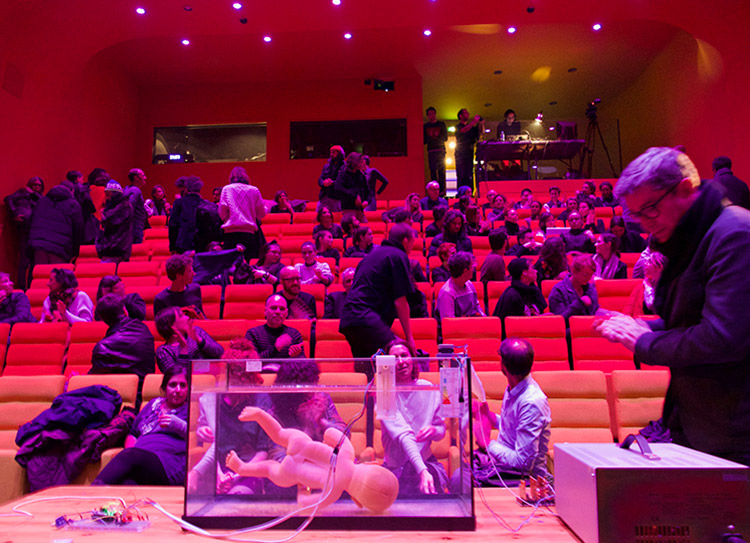
The event did not dwell on body-hacking or implanting RFID chips as a few people having contacted Makery beforehand seemed to have hoped for. Open Source Body allowed us rather to discover a set of small open source equipment usable in biology or medicine, and artistic, design or performative diversion practices. Digital microscopes using webcams, ultrasound probe on smartphone, fluid centrifuge devices using hard disks or drone motors, 3D printed prostheses, sensory tools for hearing or touch, wearables, etc. The spectrum was large…
Open Source Body did intend to spotlight interdisciplinarity and creativity in the field of open electronic equipment development for healthcare: reduction of inequality in access to healthcare through the ultra-portability of digital technologies; open source tools making orientation diagnosis easier; customization and DIY in the field of biological and medical equipment; public health bio-politics, bio-ethics and healthcare democracy; design and interactivity in the field of medical assistance and ecology; new mediums for body art and creation…
Workshops conducted briskly with gusto
The festival started on January 22 with three interdisciplinary workshops at la Paillasse. We can never thank enough the team from this eco-citizen lab (Marc, Zoé, Jonathan, Cléa…) for their commitment and patience!
From Monday, the group gathered around the Unborn0x9 project from the artist Shu Lea Cheang got to work and led an intense week of hacking and development of Pure Data patches around the sonication of ultrasounds. The team made the chief DIYers from Labomedia in Orléans, Jérôme Dubois, the acoustician engineer from the echo-stethoscope association Echopen, and the musicians and artists invited by Shu Lea ponder.
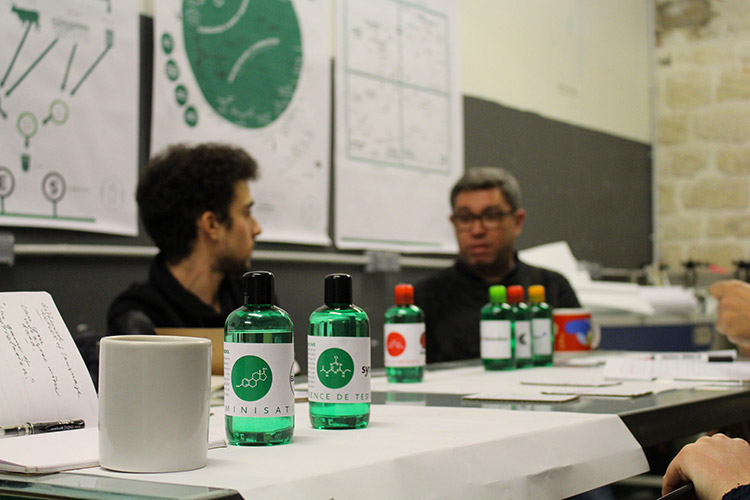
Another group gathered around Xavier Fourt from the collective Bureau d’études designed a board game on the controversy of endocrine disruptors for the tactical theater project Aliens in Green. Assessment by Xavier: “We moved forward considerably this week, thanks to the participants in the workshops.” The first draft of the game will in fact be tested at the end of this week during the event “Nous ne sommes pas le nombre que nous croyons être”, (We are not the number we believe to be) on February 2-3 at la Cité internationale des arts in Paris.
Having being delayed at the start due to bad weather threatening their vehicle, the artist from Barcelona Paula Pin and her team finally turned up with fanfare at la Paillasse. Lots of noise and participants as soon as they began: “We did say there would be noise disturbance,” says Marc Dusseiller, laughing.
The week was as active in discussions as in tool constructions: biological centrifuge devices diverting hard disks, sonication of mushrooms, laser tinkering and crystallography, Open Theremin, DIY microscopes, 8bit mix tapes and other micro-synthesizers, salvaging clothes with “HardGlam” potential (including false diamonds) in rue Saint-Denis and recycling la Paillasse waste into DIY devices with no particular use… other than producing noise.
View this post on InstagramA post shared by Makery France (@makeryfr) on
Mid-week, at the CRI in its tour Montparnasse premises in front of fifty or so participants, André Maia Chagas presented his FlyPi microscope printed in 3D and developed using a Raspberry Pi and a digital mini-camera. The rendezvous, as part of the European program Doing It Together Science was also the opportunity to discover the low-cost protocol for the detection of the presence of GMOs in food, designed by the Israeli Guy Aidelberg, or still PreemieAlert, a frugal connected wearable to support caretakers in tending to premature babies.
As an appetizer to begin the week-end for the public, la Gaîté lyrique hosted on the Friday evening a reception with the restitution of the workshops of the week.
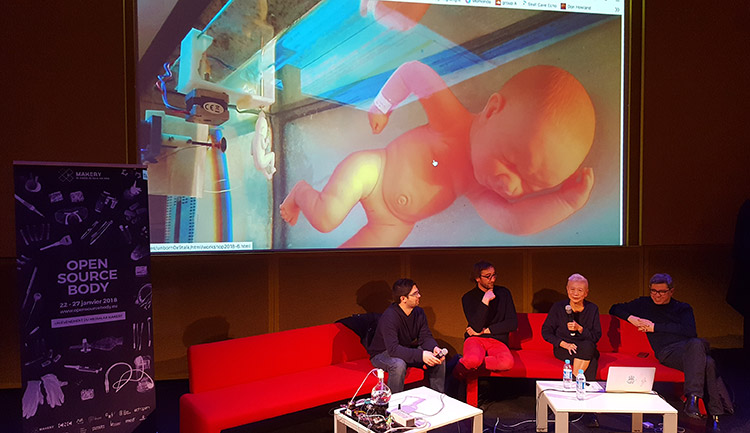
Urs Gaudenz (Hackteria, GaudiLabs) at Open Source Body 2018:
Discovering DIYbio prototypes
On the last afternoon of Open Source Body, the opportunity was given to attend several prototype demonstrations at the resource center of la Gaîté lyrique in the presence of their designers. This meeting between scientists, healthcare professionals, designers and artists gave free rein to a whole range of devices on the border of playful colorfulness and paramedical innovation.
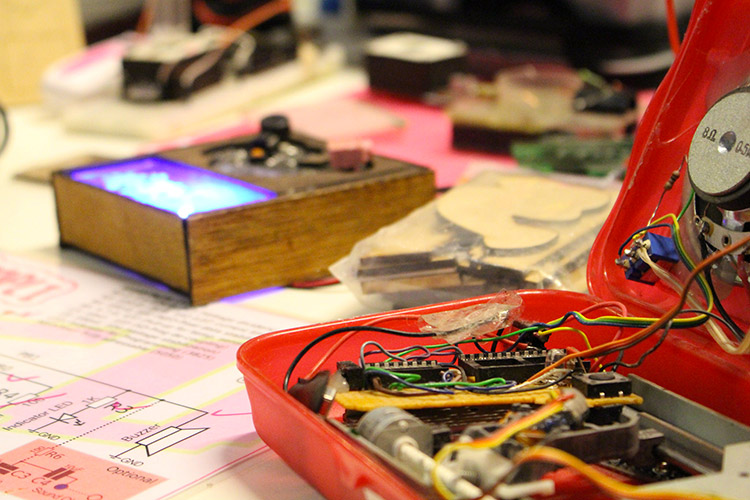
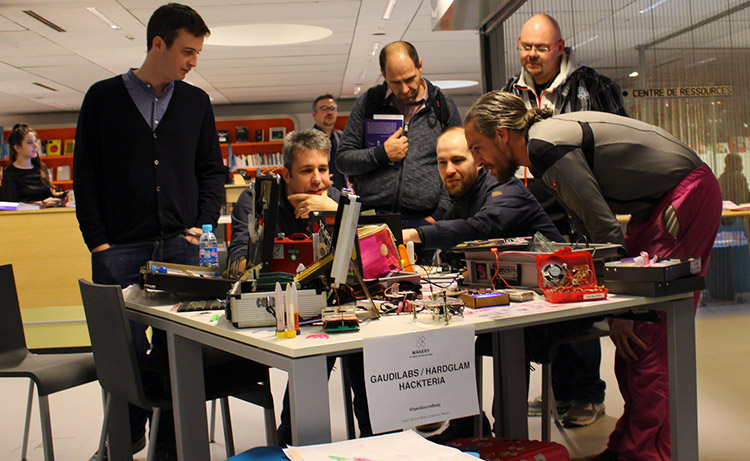
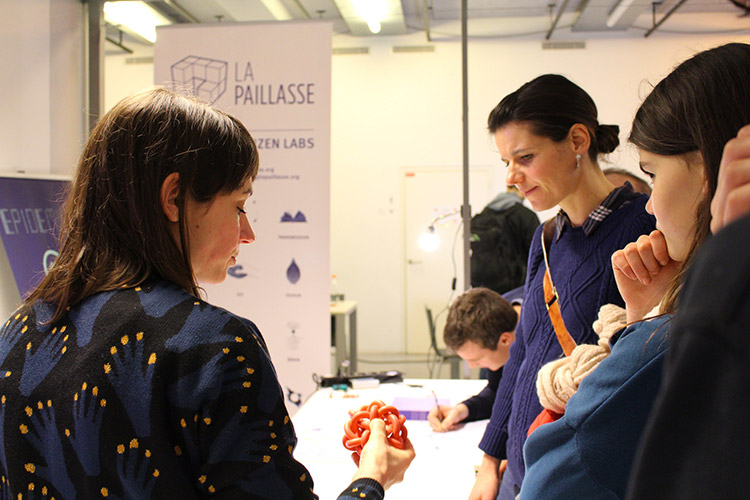
In addition to those coming from the biohackers of GaudiLabs, Hackteria and Pechblenda, one could also manipulate the music instruments/toys to be touched made from tactile sensors, developed especially for a public of young autistic people by Muriel Colagrande, in residence at la Paillasse with her project Ovaom.
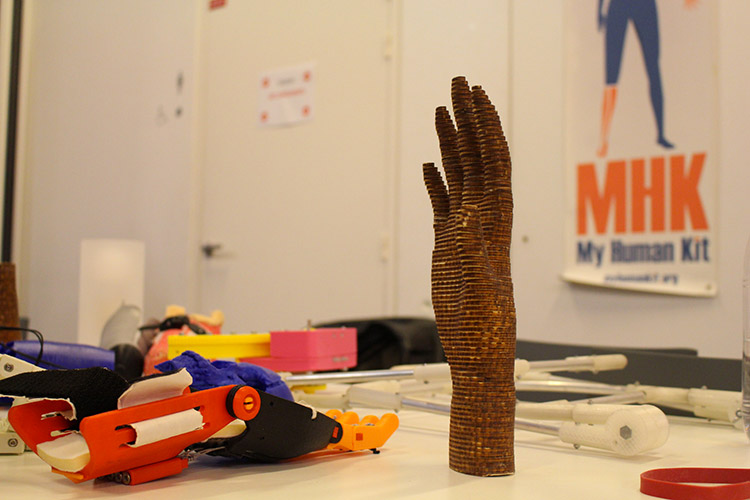
Delphine Bézier from the association My Human Kit guided us through the discovery of tools created for disabled people, including the Hackberry myoelectric hand from the Bionico project bringing new functionalities (such as the rotation of the thumb) to the open source bionic hand printed in 3D from the Japanese company Exiii; a rotary headrest allowing you to move your head designed especially for a young girl suffering from a neurodegenerative disorder; or a wheelchair made from wooden pallets with an Arduino card, salvaged small motor and joystick, the lot for less than €80. We (re)discovered the kit of object representations by analogy of the functions of women’s genital organs designed by the designer Fanny Prudhomme under the code name Les Parleuses (we talked to you about it over here).
Following the example of Fanny Prudhomme, ENSCI graduate (Higher national school for industrial creation), the enhancement of work from the students of this school, in partnership with an institution as famous as the Pasteur Institute, was brought out by the presentation of their joint project Æther, that won an award at the iGEM 2017, (international Genetically Engineered Machine) competition, a synthetic biology competition organized every year by the American MIT. Æther is presented as a kit to fight indoor air pollution and these much talked about endocrine disruptors coming from the incomplete combustion of a certain number of toxic materials and capable (by a “hormonal lure” phenomenon) of causing organic dysfunctions and cancers in humans.
Researcher at the Pasteur Institute, Deshmukh Gopaul highlights the effectiveness and the low manufacturing cost of this object operating as a fan equipped with a filter and enzymes biodegrading undesirable particles. “The fan itself comes from a PC and only requires a few watts, he explains. The external surface powering it functions like a solar panel. But since it works with photons, an elementary particle permitting the transportation of electromagnetic waves such as light, it doesn’t even need to be exposed to the sun to be operational.”
The most low-cost and unwonted project was Guy Aidelberg and his Open GMO Gene Detection prototype, a genuine station capable of detecting GMOs made from a simple kettle and a LED card. Inserted in a pipette with a little water and enzymes, the analyzed food extract is heated at 63°C for an hour before being placed to the LED pointer under a cardboard box. The more fluorescent the content of the pipette is, the more the level of GMOs detected is important. A device that should therefore be a huge success!
Healthcare professionals and biohackers
The Gaîté lyrique auditorium held in conference mode a meeting between healthcare professionals and equipment developers as part of the National days for innovation in healthcare. Jean-Yves Fagon, ministerial delegate for innovation in healthcare opened the conferences: “You are creating an unusual and interesting development model for innovations.” The professor encouraged the renewal of the experience the following year (You’ve been warned…): “I would like us to hold our three National days for innovation in healthcare at the same period [as Open Source Body]. We can all benefit from exchanging while keeping your specific features to reach the common objective” of innovation in healthcare.
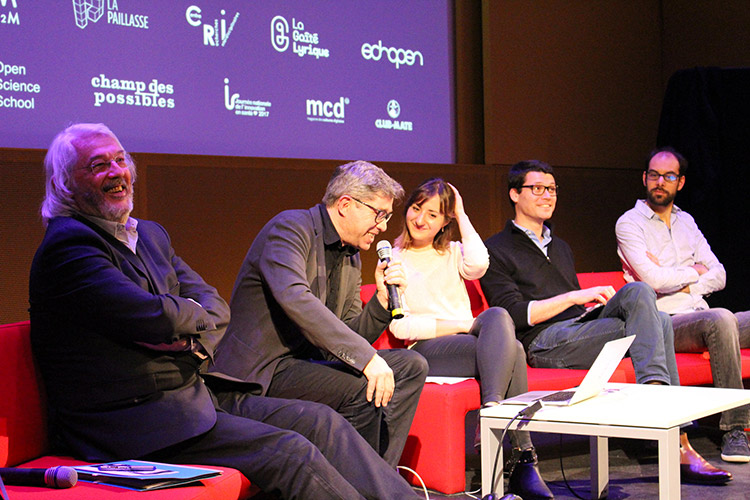
Round tables followed each other at a rapid pace (we nearly regretted not having enough time for exchanges) on collaborative laboratories, or still low-cost portable laboratories for emerging countries. François Piuzzi from Physique sans frontière gave a panorama of low-cost or recycled equipment, especially highlighting those developed by the Hackteria networks and Global Open Science Hardware. Jean-Baptiste Ronat presented the MiniLab from Médecins sans frontières: “I am bit peripheral to your event but even though it isn’t possible for us to develop a 100% free operational laboratory, we are however using bricks of open source.” Marc Dusseiller, the “historical” biohacker half way between bio-art and the development of generic laboratory equipment, told us how, over the years, he “trained in dozens of workshops maybe 5,000 people to produce microscopes from webcams, who themselves have probably trained up to 20,000 other people today.” He came to the conclusion: “We have always been biohackers.”
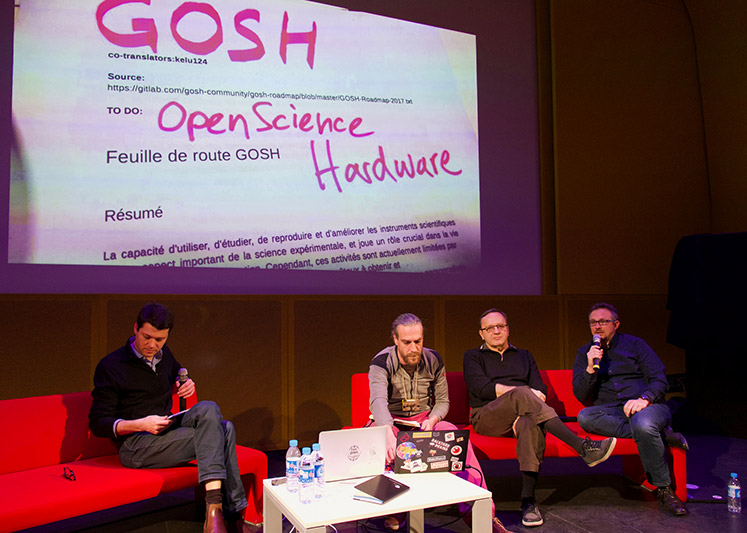
The focus of the last round table was on equipment for diagnosis orientation in gynecological healthcare. Isabelle Giami from Gynécologie sans frontières explained the sometimes problematic lack of security and equipment regarding midwifes’ interventions with migrant or refugee women, emphasizing the potential interest for a portable ultrasound probe for detecting breast cancer. Hélène le Bail, volunteer coordinator for the Lotus Bus from Médecins du monde caring for Chinese sex workers in the districts of Belleville or Strasbourg-Saint-Denis in Paris, explained how although they use the Trod (rapid self-test for diagnosis orientation) to detect HIV, HCV and other infections, it remains difficult to carry out these tests in the field considering the possible social stigmatization in the community of women prostituting themselves and the abruptness of the personal information delivered without sufficient psychological support. Open to the tools to come, these field experts listened to doctor Mehdi Benchoufi from Echopen explain the development phases of the open source echo-stethoscope and his hopes to put it into the hands of NGOs within the next two or three years.
Evening bio-sound assaults
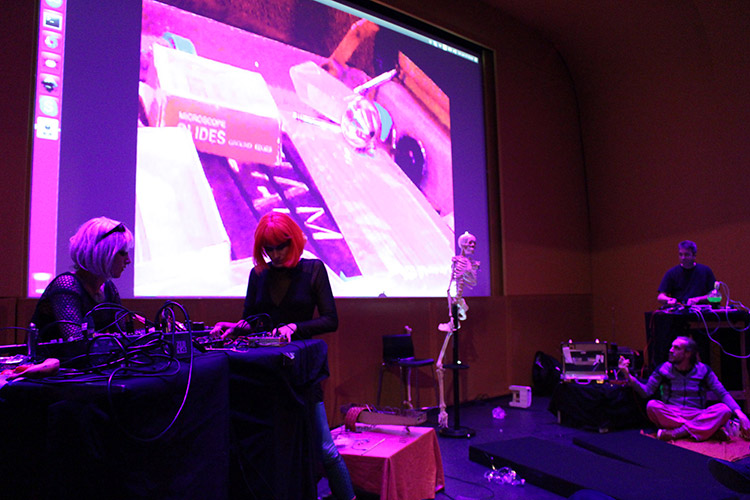
Regarding live performances, several musical devices tinkered during the “Open Science Friction and Noise Disturbance” workshop during the week at la Paillasse were seen in the front line of the post-porn show concocted by Paula Pin and Hackteria.
Instruments tinkered in circuit-bending mode that, combined with the Bio-trans.lab mobile array, Paula’s HardGlam briefcase and Urs Gaudenz’s Open Theremin, led consented crude sonic assaults in an obviously very electronic body music audiovisual staging.
More disciplined, the Unborn0x9 performance imagined by the artist Shu Lea Cheang, in the wake of the workshop carrying the same name, managed to reconcile a complex multimedia process with writing (joining real time recording processes of ultrasound data from an open source probe under the auspices of the team of labs Echopen and Labomedia, live musical and resounding transformation/restitution by Joachim Montessuis, Gaël Segalen, Paula Vélez, David Bair, and integration of feminist texts read by Catherine Lenoble and Jérémie Bordelo and recorded stories of pregnant women).
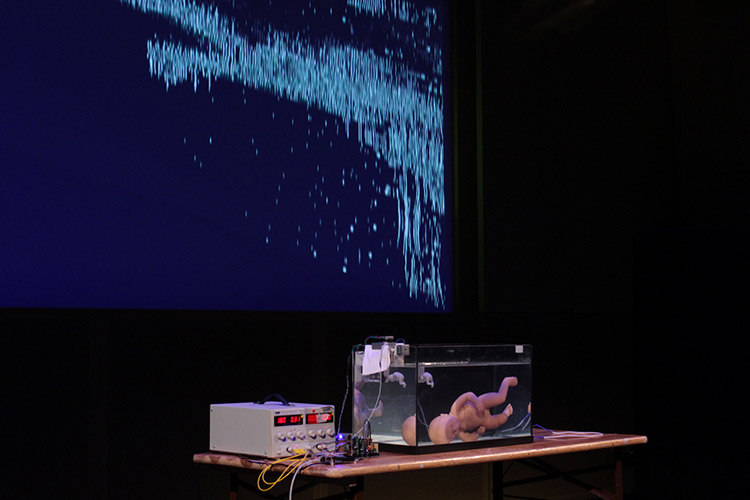
A true narrative tour de force given the limited time awarded to the realization of a project, of which the mixed up and live nature of the different components—particularly intrusive, even unsettling in their sound or psychological dimension—formed the true hearth of Open Source Body. Huge thanks to the artists, biohackers and performers!
See those who made the Open Source Body festival in eight portraits
